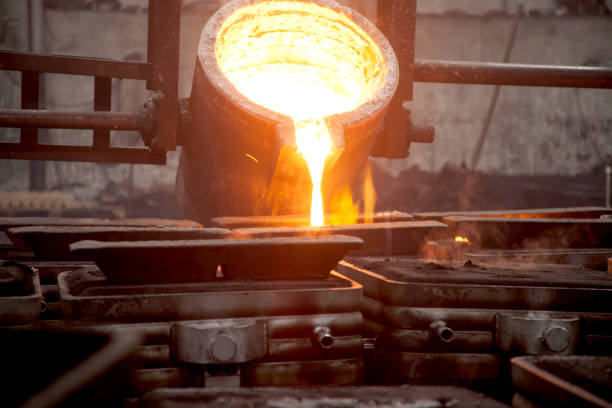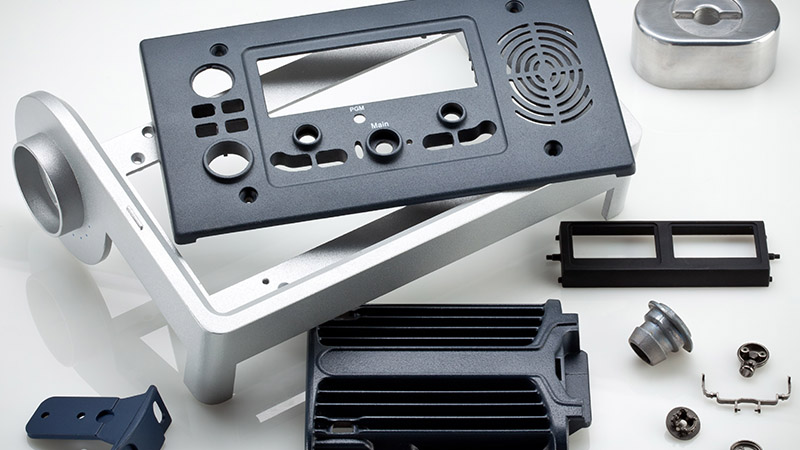Discovering the Important Applications and Uses of Aluminum Foundry in Modern Manufacturing
Light weight aluminum factories play a necessary role in contemporary production, offering varied sectors with their one-of-a-kind residential properties. From auto parts that enhance fuel performance to aerospace structures that focus on weight, aluminum's versatility appears. Its applications include building and construction and consumer electronic devices, highlighting its resilience and power effectiveness. The technologies in light weight aluminum spreading methods and future fads necessitate a closer examination, as they may redefine its effect on manufacturing.
The Duty of Light Weight Aluminum Foundries in Automotive Production
As the vehicle market progressively focuses on light-weight products to enhance gas performance and efficiency, light weight aluminum factories have actually ended up being necessary factors to manufacturing processes. These foundries focus on creating parts that fulfill the rigid demands of contemporary automobiles, such as engine blocks, transmission housings, and architectural components. Light weight aluminum's positive homes-- such as high strength-to-weight proportion, rust resistance, and exceptional thermal conductivity-- make it an ideal selection for automobile applications.
Aluminum factories utilize sophisticated casting strategies, including die spreading and sand spreading, to create sturdy and detailed parts. This capacity permits producers to optimize styles for performance while lessening weight. Making use of aluminum additionally sustains sustainability objectives, as it is very recyclable and reduces energy intake in lorries. By facilitating the assimilation of aluminum into vehicle style, foundries play a crucial function in shaping the future of the automobile sector, advertising performance and advancement across the board.
Aerospace Applications: Lightweight Solutions for Trip
Aluminum foundries play a considerable role in the aerospace industry, where the demand for light-weight materials is vital for enhancing fuel effectiveness and performance in airplane. The distinct residential properties of aluminum, including its high strength-to-weight proportion and deterioration resistance, make it an ideal selection for different aerospace elements. These parts consist of architectural components, engine cases, and touchdown equipment, which add to total aircraft efficiency.
The use of aluminum alloys, specifically those created via innovative casting methods, permits for the manufacturing of detailed designs and intricate forms while minimizing weight. In addition, aluminum's recyclability straightens with the aerospace industry's sustainability goals, minimizing ecological effect. With continuous advancements in light weight aluminum foundry modern technologies, makers can optimize production processes, bring about boosted performance and decreased costs. As the aerospace field significantly focuses on innovations that improve performance, aluminum shops will certainly continue to be indispensable to developing lightweight services for modern flight.
Building and Building: Enhancing Structural Integrity
In the structure and building industry, a substantial emphasis is positioned on improving structural stability with making use of aluminum. Recognized for its high strength-to-weight proportion, aluminum gives durability without endangering on weight, which is vital in contemporary building layouts. Its resistance to corrosion better ensures long life, making it an ideal product for different architectural parts, consisting of light beams, frameworks, and cladding.
Light weight aluminum additionally helps with innovative layout possibilities, allowing designers and designers to produce aesthetically pleasing structures while preserving security requirements. The material's convenience enables its application in both household and industrial projects, from high-rises to bridges. Furthermore, improvements in light weight aluminum shop strategies have enhanced the precision of light weight aluminum elements, ensuring they satisfy strict building ordinance. On the whole, the integration of light weight aluminum in construction not just boosts architectural honesty however likewise contributes to lasting structure practices, provided its recyclability and energy-efficient production techniques.
Customer Electronic Devices: The Increase of Light Weight Aluminum in Innovation
In the domain name of consumer electronics, aluminum has actually gained importance due to its light-weight design advantages and superior thermal conductivity. This change not only enhances item transportability yet also boosts tool efficiency by successfully dissipating warmth. As modern technology remains to develop, the role of light weight aluminum in developing streamlined and reliable tools is significantly significant.
Lightweight Design Benefits
As customer electronics develop, the need for lightweight yet long lasting materials has actually risen, making aluminum a significantly prominent option among producers. Its low thickness enables for the development of smooth tools that are easy to make use of and bring, significantly enhancing mobility. The strength-to-weight ratio of light weight aluminum warranties that items can hold up against daily wear and tear without endangering efficiency. Additionally, the malleability of light weight aluminum allows manufacturers to create intricate forms and kinds, better adding to cutting-edge aesthetic appeals and performance. This lightweight quality likewise plays an important role in energy performance, as lighter devices require much less energy to run. Consequently, aluminum not just meets the developing aesthetic demands however also straightens with the modern concentrate on sustainability in consumer electronic devices.
Thermal Conductivity Advantages
Thermal conductivity is an important consider the efficiency of consumer electronic devices, and light weight aluminum master this domain name. Its high thermal conductivity allows for reliable warmth dissipation, which is essential for keeping optimal operating temperature levels in tools such as smartphones, laptops, and pc gaming consoles. By assisting in fast heat move far from sensitive elements, light weight aluminum aids protect against overheating, therefore improving performance and prolonging gadget durability. The lightweight nature of light weight aluminum complements its thermal buildings, making it an optimal option for mobile modern technology. As suppliers increasingly prioritize efficiency and energy efficiency, light weight aluminum's function in thermal management ends up being a lot more considerable, causing its expanding fostering in contemporary digital styles. This trend underscores light weight aluminum's significance in customer electronics technology.
Marine Market: Rust Resistance in Harsh Environments
Corrosion resistance is an important variable in the aquatic market, where equipment and structures are routinely subjected to harsh deep sea atmospheres. Light weight aluminum, especially in its alloy types, uses substantial advantages hereof. Its natural oxide layer offers a safety barrier that protects against deterioration, making it suitable for vessels, docks, and various other marine applications.
Marine-grade aluminum alloys, such as 5083 and 6061, are specifically made to endure the harsh results of deep sea and atmospheric problems. These alloys not only stand up to corrosion however also keep structural honesty and toughness in time. Applications vary from hulls and superstructures of ships to elements in overseas systems.
The light-weight nature of light weight aluminum more improves its suitability, allowing boosted gas performance and convenience of handling - Casting Foundry. As the aquatic industry remains to concentrate on resilience and efficiency, aluminum continues to be a vital material selection for standing up to deterioration popular aquatic settings
Innovations in Light Weight Aluminum Spreading Techniques
While typical aluminum spreading techniques have served the market well, current innovations are changing the landscape of aluminum production. Methods such as 3D printing of cores and mold and mildews are getting grip, permitting rapid prototyping and lowered preparations. This improvement makes it possible for manufacturers to create complex geometries that were previously tough to attain with traditional casting techniques. In addition, innovations in die-casting modern technology, consisting of making use of high-pressure die-casting (HPDC), have actually enhanced the accuracy and surface area coating of cast light weight aluminum parts, resulting in boosted efficiency in different applications.
The fostering of investment casting has permitted for greater layout freedom and reduced product waste. Developments in alloy compositions are also significant, as they enhance mechanical buildings and corrosion resistance. Generally, these growths not just enhance production procedures but likewise add important source to more lasting methods within the light weight aluminum factory sector, making it adaptable to the progressing needs of modern production
Future Fads in Light Weight Aluminum Foundry Manufacturing
The future of aluminum factory manufacturing is positioned for significant transformation through automation, boosting efficiency and precision in making procedures. Lasting practices are increasingly becoming a top priority, as foundries seek to lessen their ecological impact while meeting expanding regulatory needs. Additionally, developments in alloy development will allow the production of stronger, lighter products customized for varied applications, driving technology in the sector.
Automation in Foundry Processes

Sustainable Manufacturing Practices
A growing focus on sustainable production techniques is reshaping the future of aluminum shop production. Sector leaders are progressively adopting energy-efficient modern technologies and recycling campaigns to decrease waste and reduce carbon impacts. The use of recycled light weight aluminum substantially reduces energy intake compared to main light weight aluminum production, making it a preferred choice for eco conscious suppliers. Furthermore, ingenious casting techniques are being established to boost material effectiveness and reduce exhausts. Business are also purchasing renewable resource resources, such as solar and wind, to power their procedures sustainably. Casting Foundry. By integrating these methods, the aluminum shop sector not just satisfies governing demands yet likewise reacts to customer need for greener items, eventually paving the way for a much more lasting manufacturing landscape
Advanced Alloy Advancement
Improvements in aluminum alloy advancement are readied to play a significant role in the future of shop manufacturing, especially as sustainability and efficiency needs escalate. The market is significantly concentrating on developing high-strength, light-weight alloys that can withstand severe conditions while decreasing ecological influence. Researchers are exploring innovative compositions, such as aluminum-lithium and aluminum-scandium alloys, which guarantee enhanced mechanical residential properties and reduced weight. Additionally, the combination of advanced production methods, including additive manufacturing and accuracy casting, permits even more facility geometries and decreased material helpful site waste. As regulative stress and consumer preferences shift towards greener alternatives, the advancement of recyclable and energy-efficient alloys will be crucial. The future landscape of light weight aluminum shop manufacturing hinges on these innovations in alloy technology.

Regularly Asked Questions
What Are the Ecological Effects of Aluminum Factory Workflow?
Aluminum foundry procedures can cause considerable environmental impacts, consisting of greenhouse gas discharges, energy usage, and waste generation. Furthermore, incorrect monitoring of contaminants may bring about dirt and water contamination, impacting regional environments and communities.
How Does Aluminum Recycling Affect Factory Processes?
Light weight aluminum recycling improves shop processes by providing an economical raw material, reducing power intake and emissions. This sustainable practice boosts efficiency, decreases waste, and supports the circular economic situation, profiting both suppliers and the atmosphere.
What Safety And Security Steps Are Applied in Light Weight Aluminum Foundries?
Light weight aluminum foundries carry out different precaution, consisting of personal safety equipment, appropriate ventilation systems, routine security training, fire avoidance procedures, and equipment maintenance treatments to lessen risks and guarantee a secure functioning environment for all staff members.
Exactly How Do Foundries Guarantee Top Quality Control in Light Weight Aluminum Spreading?
Shops guarantee quality assurance in aluminum casting through rigorous product evaluations, exact temperature monitoring, standard procedures, and routine testing of cast products. These measures help preserve consistency, reduce issues, and meet sector specifications effectively.
What Are the Expense Consider Aluminum Foundry Manufacturing?
Cost consider light weight aluminum foundry manufacturing include resources costs, power usage, labor prices, devices maintenance, and overhead expenses. Additionally, manufacturing volume and intricacy of styles considerably affect overall production costs and profitability.
As the automobile industry significantly focuses on lightweight materials to boost gas effectiveness and efficiency, aluminum shops have ended up being crucial factors to making processes. Light weight aluminum factories play a considerable role in the aerospace market, where the need for light-weight materials is vital for improving gas performance and performance in airplane. Additionally, developments in aluminum factory methods have actually improved the precision of light weight aluminum parts, guaranteeing they fulfill stringent structure codes. While conventional aluminum spreading techniques have offered the sector well, current technologies are changing the landscape of aluminum production. The usage of read here recycled light weight aluminum substantially decreases energy usage contrasted to key light weight aluminum production, making it a favored selection for ecologically conscious manufacturers.